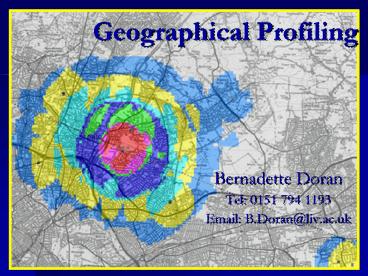Geographical Profiling PowerPoint PPT Presentation
1 / 22
Title: Geographical Profiling
1
Geographical Profiling
- Bernadette Doran
- Tel 0151 794 1193
- Email B.Doran_at_liv.ac.uk
2
Lecture Outline
- What is Geographical Profiling?
- Experiment (Part 1)
- 2 cases- Identify location of offenders home
- Geographical Profiling Training
- Experiment (Part 2)
- Re-examine cases
- You will be given the true location of the
offenders home - Have your skills as a Geographical Profiler
improved? - Development of Geographical Profiling Systems
(GPS)
3
Q. What is Geographical Profiling?
- A. Geographic profiling is an
investigative - technique that uses the locations of
a - connected series of crimes to
determine - the most probable area of offender
- residence.
- Issues- Are the offences really
linked? - Do we have the whole
series?
4
Experiment- Part 1Can you be a Geographical
Profiler?
- Instructions
- Split up into groups
- Read 2 cases
- As a group decide where you think the offender
may live - Mark X on the map where you think the offender
lives - Write down your reasons
- Report to rest of class (where you think the
offender lives and your reasons for choosing this
location)
5
TRAINING
6
Origin
- Dr. John Snow (1854)
- Cholera Epidemic
- Medical Geography
7
Origin cont
- - Shaw and Mckay (1942) The Chicago School
- Criminals do not travel far to commit their
crimes - (E.g Burglars 1.5 miles)
- - Brantingham Brantingham (1982)
- Environmental Psychology
- Spatial knowledge of an area is gained through
everyday activities. - The places frequented when not offending will
have a bearing on areas used to offend - Peoples spatial behaviour is also governed by
familiarity and effort.
8
Task- Mental Maps
- Take a piece of blank paper
- Draw a map of the area around your home
- No distance limits
- Estimate the distance from one end of the map to
the other - 10 miles?
- 5 miles?
- 2 miles?
- 1 mile or less?
9
Criminal Mental Maps
D
Pol
Pub
- -Pub
- -Home
- -DHSS
- -Police
- -Old Home
- -Canal
H
Pub
H
D
C
OH
Pol
OH
C
10
Criminal Mental Maps Cont
- FAMILIARITY WITH CERTAIN AREAS (e.g. work,
leisure, home) - Offenders home central to crime locations
- Not necessarily an accurate representation of
reality (e.g Milgram, 1976)
11
Circle Theory- David Canter
- identifying the two crime locations furthest
apart from each other. Using these locations as
the diameter, a circle can be drawn that includes
all the offences. The hypothesis is that the
criminal will be found to live inside that
circle, possibly close to the middle of it.
12
Circle Theory Cont
H
H
Marauder
Commuter
Criminal Range
Home Range
13
Experiment- Part 2Can you be a Geographical
Profiler?
- Instructions
- Mark Y where you think the offender lives
- Write down your reasons
- Find out true location of offenders home
- Measure the distance (mm) from offenders base to
X - Measure the distance (mm) from offenders base to
Y - Have your skills as a geographical profiler
improved?
14
Research Findings
- Marauders
87 UK Serial Rapists
86 UK Serial Murderers
50-60 UK Serial Burglars
15
Cross- cultural comparison
- Godwin Canter (1997) 85 of US Serial Killers
live within circle - Kocsis Irwin (1997) 71 Australian Serial
Rapist - Kocsis, Cooksey, Irwin, Allen (2002) 50 of
Australian Serial Rural Burglars
16
- Attempts to emulate theory and predict offender
residence
17
- Problems
- You cant use Dragnet to identify the base of
criminals who are commuters - It doesnt take into account land-use
18
Computers vs. People
- 21 Students in each group (control
experimental) - Ten crime series five locations for each
- Experimental group given two heuristics
- - majority of offenders homes within circle
defined by two furthest offences - - majority of offenders commit offences close to
home
19
Effect of training on prediction of home
location
Snook, B., Canter, D. Bennell, C. (2002).
Predicting the Home Location of Serial
Offenders A Preliminary Comparison of the
Accuracy of Human Judges with a Geographic
Profiling System. Behavioural Sciences and the
Law, 20, pp. 109-118.
20
Implications
- Indicates that principles involved are effective
- Uniform improvement not due to intuition or
gut feeling - May be other principles that need to be
identified, i.e. commuters - Casts doubt on utility of computerized systems
and specialized training
21
Future Directions- Incorporating Contextual
Information
- Canter Heritage (1994) Rapists who offend
- outdoors travel further than those who attack
- indoors
- Davies Dale (1995) Older offenders travel
- further
22
Selected Readings
- Canter, D. (2003). Mapping Murder The Secrets of
Geographical Profiling. London Virgin - Ainsworth, P.B. (2001). Offender Profiling and
Crime Analysis. Devon Willan - Canter, D., Larkin, P. (1993). The
Environmental Range of Serial Rapists. Journal of
Environmental Psychology, (13), 63-69. - Snook, B. (2002). Predicting the Home Location of
Serial Offenders A Preliminary Comparison of the
Accuracy of Human Judges with a Geographic
Profiling System. Behavioral Sciences and the
Law, (20), 109-118.

